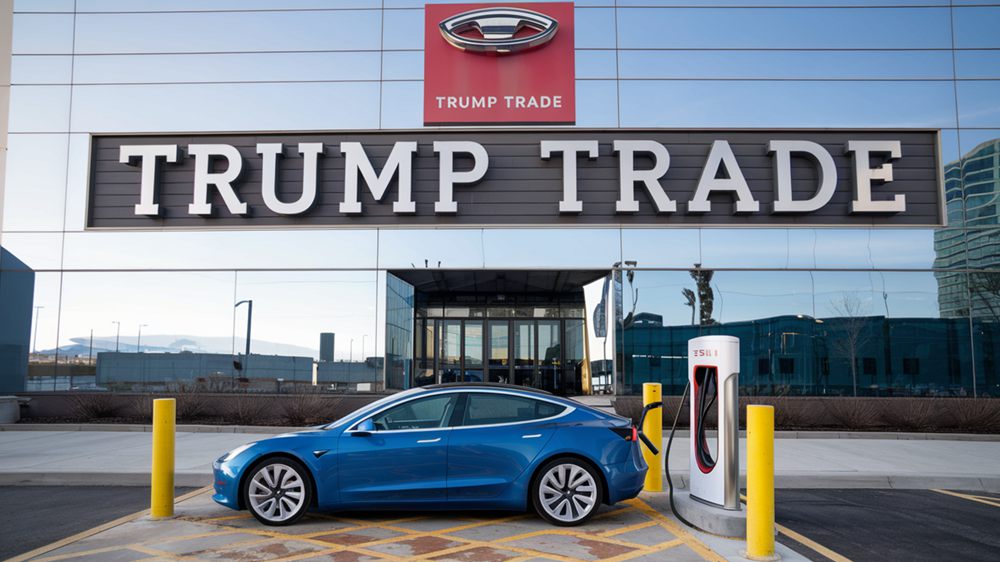Tesla Investors Continue to Profit From the Trump Trade: A Deep Dive into the EV Giant’s Future

The Trump Trade: A Catalyst for Tesla’s Stock Surge
Tesla’s stock has experienced a remarkable surge since the announcement of Donald Trump’s election victory. The so-called “Trump trade” has seen Tesla’s stock rise by over 56% since the election, with a notable 6.6% gain in the week of November 18, 2024. This surge is not just a reflection of market sentiment but also a response to specific policy expectations under the Trump administration.
Regulatory Easing: A Boon for Autonomous Vehicles
One of the key drivers of Tesla’s stock rally is the anticipated federal regulatory framework for autonomous vehicles. The Trump administration is expected to prioritize this framework, potentially simplifying the rollout of Tesla’s autonomous Cybercabs. This move could also facilitate the sale of Tesla’s software across state lines, opening new revenue streams for the company.
Tesla’s full self-driving (FSD) technology, currently at Level 2, needs to reach Level 4 for regulatory approval. A less restrictive regulatory environment under Trump could expedite this process, giving Tesla a competitive edge in the autonomous vehicle market.
The EV Tax Credit: A Double-Edged Sword
The potential repeal of the $7,500 EV tax credit is another significant factor influencing Tesla’s stock performance. While the credit has been instrumental in boosting EV sales, its removal could reshape the competitive landscape. Tesla, as the market leader in EVs, stands to benefit from this change. The company can produce EVs at lower costs without relying on subsidies, unlike some of its competitors.
However, the repeal could also lead to a decline in overall EV sales, as suggested by a report indicating a potential 27% drop in EV registrations. This presents a mixed bag for Tesla, which may need to adjust its pricing strategy to maintain its market share.
Tesla as a Proxy for Elon Musk’s Vision
Investing in Tesla is often seen as a bet on Elon Musk’s vision and leadership. Musk’s influence on Tesla’s stock performance is undeniable, with his support for Trump and substantial financial backing playing a crucial role in the recent stock surge. Musk’s strategic positioning of Tesla during a potentially less favorable regulatory environment for competitors has been a key factor in the stock’s performance.
Analyst Insights: Price Targets and Market Valuation
Analysts have been quick to adjust their price targets for Tesla in light of the recent developments. Dan Ives from Wedbush has set a price target of $400, representing a 16% increase from the current price and a 73% gain from consensus forecasts. This bullish outlook is supported by the potential for autonomous driving to represent a $1 trillion opportunity for Tesla.
However, Tesla’s high valuation, trading at 171 times forward earnings, raises questions about its long-term investment viability. The stock’s current market price is significantly higher than some analysts’ valuations, reflecting a speculative sentiment among investors.
The Broader Market Context: Challenges and Opportunities
While Tesla’s stock has rallied, the company faces several challenges. Cooling demand for its vehicles and increased competition are notable concerns. Tesla’s automotive gross margins have declined, and its projected revenue growth for 2024 is only 3%. These factors highlight the need for Tesla to innovate and adapt to maintain its market leadership.
The Role of International Markets
Approximately 30% of Tesla’s sales come from China, where Trump’s trade policies could also impact the company. Higher tariffs on imported EVs and better access to international markets could provide Tesla with advantages, but they also introduce new risks.
Conclusion: Navigating the Future with Caution and Optimism
As Tesla continues to navigate the complexities of the EV market, investors must weigh the potential benefits of the Trump trade against the inherent risks. The anticipated regulatory changes and the potential repeal of the EV tax credit present both opportunities and challenges for Tesla.
For individual investors, the key takeaway is to stay informed and adaptable. Tesla’s stock remains a proxy for Elon Musk’s vision, and while the current market sentiment is bullish, it’s essential to consider the broader market dynamics and Tesla’s long-term growth prospects.
In conclusion, Tesla’s journey in the post-election landscape is a testament to the dynamic interplay between politics, innovation, and market forces. As the company continues to push the boundaries of what’s possible in the EV space, investors should remain vigilant, ready to capitalize on opportunities while managing risks effectively.


